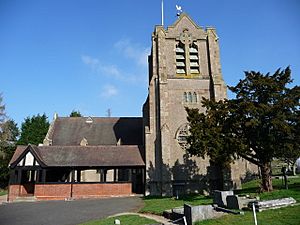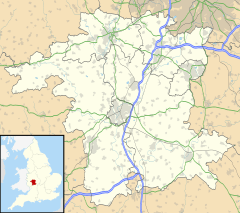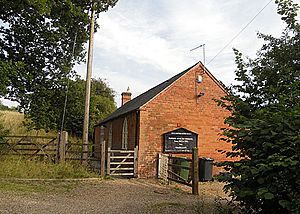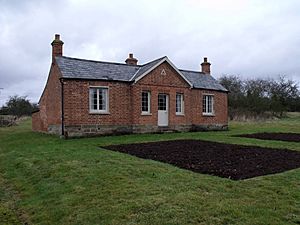Dodford, Worcestershire facts for kids
Quick facts for kids Dodford |
|
|---|---|
 Holy Trinity and St Mary's church |
|
| • London | 122 miles (196 km) |
| Civil parish |
|
| District |
|
| Shire county | |
| Region | |
| Country | England |
| Sovereign state | United Kingdom |
| Post town | BROMSGROVE |
| Postcode district | B61 |
| Dialling code | 01527 |
| Police | West Mercia |
| Fire | Hereford and Worcester |
| Ambulance | West Midlands |
| EU Parliament | West Midlands |
| UK Parliament |
|
Dodford is a small village in Worcestershire, England. It's about 3 miles (5 km) west of Bromsgrove. Dodford was officially started on July 2, 1849. It was founded by people from the Chartist movement. This group wanted to help working-class families own land. Dodford was one of five special settlements they created.
The village still has a unique grid-like street plan. You can also see narrow lanes and many plum and pear trees. These trees are a reminder of its past as a place for growing fruits and vegetables. The area of Dodford with Grafton has about 731 people living there.
Contents
Dodford's Early History
Dodford was once home to a place called Dodford Priory. For a while, Dodford was part of a huge royal hunting ground. This area was called Feckenham Forest. King Henry II made the forest much bigger. It covered a large part of North Worcestershire, including Dodford. Later, in 1301, King Henry III changed the forest boundaries back. This meant Dodford was no longer under strict forest laws.
What Does Dodford Mean?
Experts who study place names believe "Dodford" comes from old English words. It likely means "Dodda’s Ford." A "ford" is a shallow place in a river where you can cross. However, there is no proof of people living here before the Normans arrived. The name "Grafton" means "settlement near the wood." This might suggest it was a place for managing woodlands.
Important Buildings in Dodford
Dodford Priory
Dodford Priory was a small monastery. It was founded in 1184. Most likely, King Henry II started it. The monks who lived there were called Augustinian canons. They owned land around Bromsgrove. The priory was not very rich. In 1291, tax records show it earned only £4 17s.
By 1464, the priory was almost empty. Only one canon remained. So, King Edward IV ordered it to join Halesowen Abbey. The priory was finally closed down in 1536 or 1538. This happened during the time of the Dissolution of the Monasteries.
Today, you can still see parts of the old priory site. It was shaped like a triangle. There are also signs of a moat or fishponds. Some parts of the old buildings might be included in the current listed building on the site.
Monsieurs Hall
Monsieurs Hall is an old farmhouse. It was built in the 1600s. You can find it on Monsieurs Lane. This lane is off Kidderminster Road.
Churches and Chapels
Dodford once had a Baptist chapel. This chapel is now closed. A Mission Church was also built. It was officially opened in 1863. This church stood where Dodford's village hall is today.
Dodford School
Dodford School first opened in 1877. It is now a First School. Children from across Bromsgrove attend it. They learn there until they are nine years old.
Church of the Holy Trinity and St Mary
The Church of the Holy Trinity and St Mary was built between 1907 and 1908. The money for it came from Walter Whinfield. He was a church leader at St John’s Church in Bromsgrove. The church was designed by Arthur Bartlett. He used the Arts and Crafts style. The beautiful decorations inside were made by the Bromsgrove Guild.
Many of the wooden carvings are special. These include the pulpit and altar rails. They were made by Celestino Pancheri. The church is considered one of the best of its time in the county. Its design is unique and very effective. The details inside are also very interesting. The ceiling ribs are said to show "the fruits of Dodford." One of the front benches has a carving of John Bungay. He was the first child born in the Chartist village in 1849.
Dodford and the Chartist Movement
The Chartist movement was a group of people who wanted fairer rights for working-class people. In 1845, they started the Chartist Co-operative Land Society. Their goal was to help working families own small plots of land. They hoped families could earn a good living from these plots. Around 70,000 members paid money to join. They hoped to win a plot in a lottery. Five settlements were created. Dodford, originally called Great Dodford, was the last one.
Chartist leader Feargus O'Connor bought the land for Dodford. He bought the Dodford Priory site and 273 acres nearby. This happened in January 1848. He paid £10,546 for the land. O'Connor hoped to settle 70 families there. In July, 5,000 Chartists from the Midlands met at Dodford. O'Connor promised them the settlement would be finished.
A special committee looked into the land scheme. They said giving out plots by lottery was against the law. So, at Dodford, plots were given to those who paid the most money upfront. This was not what O'Connor wanted. He wanted working-class people to get the plots.
'Location Day' was when the new settlers arrived. It was July 2, 1849. The first year was very hard for the settlers. The plots were not ready. There were open wells but no water pumps. Crops like wheat had not been planted. Many settlers had to keep their old jobs. They worked in Bromsgrove or from home. They even hired others to work their plots.
The company that ran the scheme was eventually closed. Dodford residents did not pay rent. So, tenants were given a choice. They could buy their land. Or, they could keep paying rent to a new owner.
Chartists from the West Midlands helped the new settlers. They brought tools and visited often. A special "Dodford digging fork" was even made. It helped with the heavy red soil.
Unlike other Chartist settlements, Dodford became successful. This was because it could sell its produce to nearby Birmingham and the Black Country. These areas had growing markets.
One settler, John Wallace, realized the soil was good for strawberries. He suggested growing them in the early 1860s. From then until about 1920, strawberries were the main crop in Dodford. The "Joseph Paxton" was a popular type of strawberry.
The small farmers sold many things. They sold strawberries, flowers, peas, beans, and shallots. They also planted orchards with pears and plums. An annual 'Strawberry Wake' was held every July. Visitors could eat as many strawberries as they liked for 6d. This tradition lasted until 1922. Garlic was also sold to a company in Worcester called Lea and Perrins. Many plot holders also kept other jobs. They made nails or gunlocks. Some ran shops. One plot holder, John Ward, was a butcher. He ran a pub, which is now the Dodford Inn.
Dodford's success was used in the 1880s. People like Jesse Collings used it to argue for land reform. They wanted more places like Dodford in England.
Dodford remained successful for a long time. It kept its strong, independent spirit until the 1890s. However, new strawberry farms started in nearby Catshill. They grew strawberries earlier on lighter soil. This made prices go down. Dodford had a short boost during World War I. Strawberries were sold to Cadbury's for jam. But after the war, the tradition ended. People bought plots as country getaways. Strawberry quality dropped due to disease. Also, better jobs were available at the Austin Motor Company factory in Longbridge. The cheap workers who picked strawberries also disappeared. The nail-making industry in Bromsgrove also declined.
Dodford Today
Dodford is now a special conservation area. This means its historic character is protected. Many buildings are "listed." This includes several Chartist cottages and the Church of the Holy Trinity and St Mary. Rosedene is an example of a Chartist cottage in Dodford. It is owned by the National Trust. You can visit it by making an appointment.




